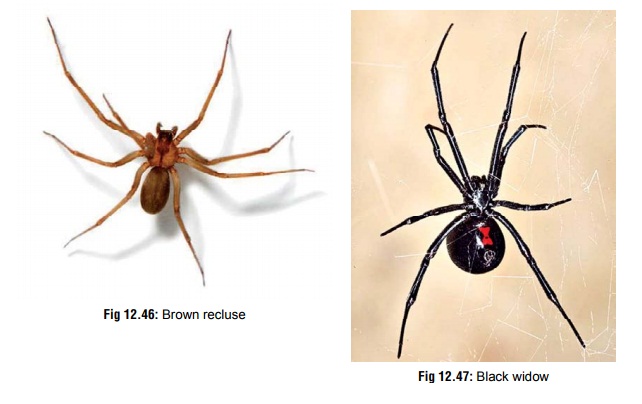Chapter: Modern Medical Toxicology: Organic Poisons (Toxins): Venomous Bites and Stings
Order Aranea - Venomous Arachnids

ORDER ARANEA
·
All spiders, with the exception of two small groups, are venomous.
There are over 100,000 species of spiders. However, only about 20 species cause
serious envenoming in humans, while about 150 to 180 can cause significant
toxicity.
·
The common Indian species that cause serious envenoma-tion
include Brown Recluse, Black Widow, Wolf Spider, and Tarantula. Other spiders
such as Orb Weaver, Running Spider, Hackled-band Spider, Giant Crab Spider,
Lynx Spider, Jumping Spider, and Tangleweb Weaver, which are also encountered
in India, do not cause significant envenomation. Funnel Web Spider which can
cause significant envenomation is found only in the Australian continent.
General Anatomy
·
Anatomically, a spider has a cephalothorax and an abdomen
with 4 pairs of legs fanning out from the thorax. Two claw-like fangs called
celicera protrude from the head and are connected to venom glands which are
under voluntary control.
·
Although the venom is quite potent in many species, serious
envenomation is rare because of inadequate injec- tion mechanism, and small
quantity injected with each bite.
·
During its normal life span of 1 to 2 years, a spider moults
several times, as a result of which there may be periodic changes in colour and
markings.
·
Spiders are extremely shortsighted, and depend mainly on
sense of touch and vibration. The eyes are on the front part of the
cephalothorax. Most spiders have 8 eyes. Their size and position varies by
spider type.
· Some large spiders (e.g. huntsman
spider, wolf spider, orb weaving spider), possess large spines on their legs.
The spines are raised from a prostrate to a vertical position when the spider
is irritated. If the spider is grabbed, picked up, or brushed off, injuries
(severe pain, erythema, pruritus) from the spines may occur. These injuries
often occur in conjunction with a bite by the same spider, and splinters are
usually found at bite sites.
Related Topics